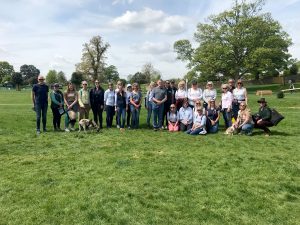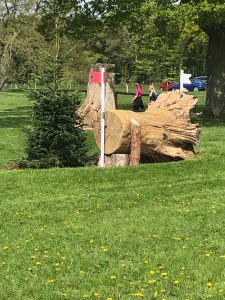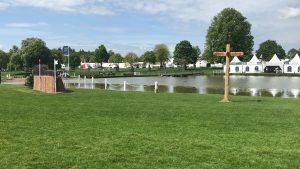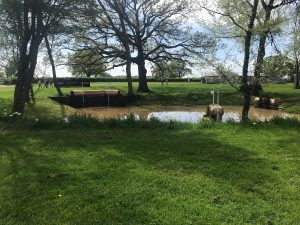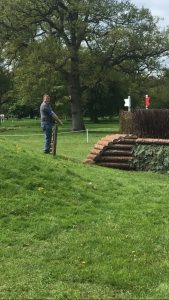F&I Badminton Course walk with Nick Turner
5th May 2022.
Well, what a treat. Not only to be back at Badminton Horse Trials to watch all the action, but the sun was shining, and we were in for a real treat being guided round Eric Winter’s 2022 course by Nick Turner FBHS.
The course was running over 6688 meters with an optimum time of 11min 44seconds. The going looked perfect and fence two where we all met looked Huge.
Once everyone was gathered, we set off and soon arrived at the Quarry – the first combination and the first real question. And, as Nick pointed out, the first time the horses really see a crowd. They are jumping in over a big log on top of the hill. Then curving left to jump the wall at the bottom then ride up on a right-hand curve to a big skinny brush. We talked about distance between the wall and brush and interestingly Nick said he’d be scared to see it ridden on three strides and he thought it walked on a nice 4 strides. I’ll let you decide which distance you thought worked best.
Next fence was a good accuracy test over a log that was positioned rather awkwardly off your line, and so those going for the time were really challenged to take the inside line and jump on the angle, while there was an option to go around the tree and ride a much easier line. I’d say this fence didn’t cause much trouble throughout the day, although as there was not a camera there we didn’t really see it jumped.
We then came into Huntsman’s Close and here again a true test of line and accuracy. From where we walked it was quite difficult to see exactly where your line went. But Nick very kindly walked the line for us. Nick was very focused on talking about making sure the riders need to finish the line and talked a lot about how Eric was really trying to encourage forward positive riding.
Fence 7 was a single fence on the way to the lake. And although a straightforward fence, was big, square and still needed respecting.
Onto the lake next. A run through the water to an acutely angled brush coming out. Nick talked here about the importance of having the ability to have the horse reactive in the last few strides to your fence. The horses then ran down to the head of the lake to jump a big log in, to a skinny brush in the water to a skinny brush coming out then on down to a square jump with water cascading over it.
A double of egg boxes next on a straight two strides. A combination designed to just put the balance back into the horse before a long gallop down to what was to be the most intense part of the course.
The next fence is a new jump this year, a broken bridge. Nick talked about keeping the horse’s hind leg under them as you ride up the ramp with power and energy. A brilliant fence to look at when not riding and great for spectators too.
We then came down to a combination of three brush fences. In over a maximum height brush parallel to two brush corners. The distance was there for 6 strides a-b then 3 strides b-c. Again, this was encouraging forward bold riding while testing the accuracy on two curving lines.
Down to the first part of the Vicarage ditch. Jumping a foot bridge parallel across the ditch at an angle. From a distance looked very jumpable but when you got down to it the ditch was big, and it gave the riders an indication as to how their horses were feeling about ditches.
Straightforward roll top next on your way uphill to a decent (2m) drop into a pond with a curve 3 strides to a jump in the water. There was water cascading over the B element here but that really didn’t seem to bother the horses. Nick reiterated the importance of making sure you had the horse’s hind leg under them as you came to the drop which was very steep.
Next was another combination, brush-ditch-brush. The challenge here was the C element which was a narrow brush positioned on a down hill approach. Nick suggested that ideally the horses would take the C element on two strides so to take off from the top/middle of the hill. I saw some riders achieve this but most horses went on the three strides.
Up the hill to another combination. In over a wide-open corner ab to a second wide open corner after going across a dip in the ground. But the second corner came up very quickly without much time to get the horses on to the line. There was an option here to go longer route to give you a much nicer line to the final corner.
This was a great fence to watch, and you saw so many different outcomes for the riders. Some frangible pins going and lots of red flags being taken out. The highest of praise from Chris, my non horsey other half though as we watched Kylie ride through here. She looked totally on point and Chris said that was the best ride he’d seen through here all day.
We then headed back to the Vicarage V – angled ditch and rails – and here Nick talked again about how important it was that the riders didn’t allow the horses to gallop and open up in their stride from too far away. The riders had to really keep the hind leg and the power of the horse underneath them. Instead of leading the riders straight down to the Vicarage V though, they first jumped a triple bar over a ditch which then led them on a curved line to the narrow rail sticking out across the main Vicarage V. Nick’s words of wisdom to his riders here was to take the label off this fence, it’s just another jump! Easy to say! Eric has given the riders a little more length on the rail this year which did make it slightly more inviting. If that’s possible.
Riders are just past the 8-minute marker as they come through the Vicarage V and so Nick said that they will start to feel a slightly tired horses here, especially those that are new to this level and this kind of endurance test.
Solar panels next, with two options for lines here, left hand route with three elements which included the bounce coming out. Or the right-handed route which had a more curved line and an additional fence to jump. To my knowledge very few jumped the right-handed line – but the bounce caught a few.
Fence 25 next and a single fence but a big solid fence which he talked about making sure you keep the horse’s jump here and for riders to not get too excited that they are nearly home.
A combination next with a wicker basket into a solid fence on a 4-stride distance then onto another basket which was offset from your line. A great looking fence but was an influential one which did end up having the third part of the line taken out.
Another single fence next but again the fence offset from your line so making the riders find the best approach for them and their horse at this late stage in the course.
As we walked on to the next fence, we went past the warmup area and so stopped here for a quick discussion on warm up techniques and strategies. Nick also talked about our responsibilities as coaches at this stage. How now is not the time to start teaching the rider, but just to support and encourage.
Up to the last combination now. Two large hay feeders which led you down to three options of skinny hay feeders. Several elements here including ground undulation, slightly different lines but nothing too challenging if you’ve still got a horse with you and jumping.
We did stop here for a moment to talk about the difference in eventing, the courses and fitness for the modern-day event horse compared to the days of roads and tracks. Interesting to hear Nick talk about the lack of knowledge and understanding of how to get the endurance fitness incorporated into the horses work in preparation for the three-day events with 11-12 minute XC runs.
Onto the final three fences now and home is in sight. But still plenty to jump. A very upright narrow house after coming though a little covered pen. Again, the importance of power, balance and the hind leg was brought up!
A log next which was coming from open country towards the main arena and then finished with a kind profile fence but positioned on a turn through to the finish line and even this fence managed to catch some out.
All in all, a great and informative course walk and I really urge any of you if you get the chance to do one of these walks, they are so interesting.
Big thanks to Nick for taking the time to walk us round and to Ann for organising it.
Report by David Llewellyn BHSI

